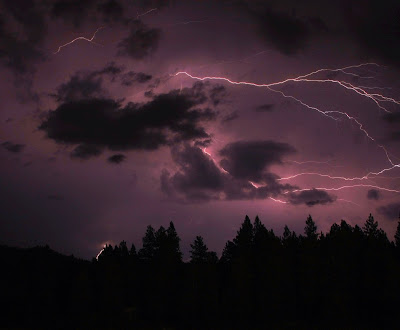For backpackers, September is usually the
sweet spot during the hiking season. Typically, the summer heat has abated, and
bug season has diminished significantly, if not completely. Huckleberries are
ready at hand for hungry hikers and the fall colors are nigh. Not this year, however, and unfortunately, it’s becoming a disturbing trend.
Perhaps the worst season ever, lightning-caused wildfires have
scorched timberlands throughout the Pacific Northwest and Alaska in 2015 (top photo courtesy of former USFS
colleague Roger Wallace). Up to 60 large wildfires are burning over eight million acres in the West. Unless El Nino
suddenly appears, the record set in 2006 will fall.
The question is: will this new wildfire environment become more the rule than exception? Climate change and a
long-standing U.S. Forest Service policy of suppressing wildfires have created
a backlog of fuels, allowing fires to burn hotter and more intensely. Smoke
filled the skies for our entire 400-mile trip from Eugene to Leavenworth.
Changing climate conditions the past few years have
certainly played a role. Average summertime temperatures are increasing
throughout the Northwest and winter snowpack has been meager compared to
previous years. The National Weather Service said the summer of 2015 was the
hottest on record in many Northwest cities and towns.
But in addition to warmer climes, forests teeming with dry
fuels have become the norm since “The Big Blow Up of 1910,” a wildfire that
burned three million acres in Washington, Idaho and Montana, killing 87
people, mostly firefighters. Since then, the Forest Service has become quite proficient at wildfire suppression.
Today, however, the agency struggles to keep up with the
conditions of new types of “mega-fires” transforming the West. What was once a
“forest fire” is now a wildfire, threatening homes in rural woodlands and urban
forests alike. Conditions of drought, high temperatures and plentiful fuels have conspired to create a perfect firestorm.
As a seasonal firefighter during my college years, I know full
well how wildfire can ravage a forest. Despite portrayals in the media and in
the movies, fighting forest fires is no glamour detail, I assure you. It’s
hard, dirty and dangerous work, and those working on fire lines throughout the
West deserve our gratitude and support.
It now appears we are beginning to learn that these mega-fires could
become more commonplace. My former colleague from the University of
Oregon School of Journalism and Communication, Katie Campbell, now an
environmental reporter for PBS in Seattle, provides a great overview of
what’s involved in fighting wildfires.
It’s an unprecedented move, and one that shows that fire
managers learned much from the Chiwaukum fire in 2014. What’s complicating
matters is the number of dead and downed trees in the Chiwawa River Valley. The
western pine beetle has destroyed vast stands of lodgepole pines in an
epidemic caused by unusually hot, dry summers.
As the comedian Pat Paulsen noted, the number one cause of
forest fires is trees. As we come to grips with this changing physical
environment, wildfire managers will need to continually reevaluate strategies
and tactics, and how to fund the associated costs, in protecting the public -- and their homes -- from wildfires.







No comments:
Post a Comment